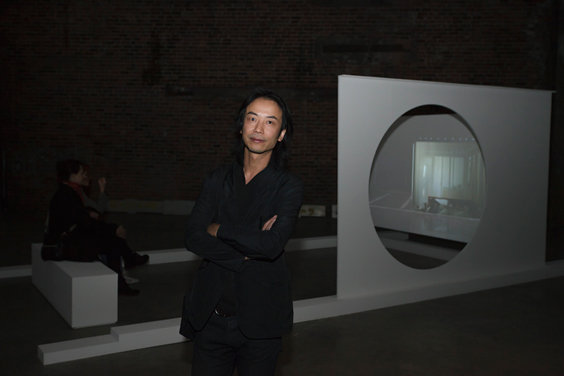
Yam Lau in front of his video installation “Room: An Extension” (2008) at Darling Foundry, Montréal. Photo by Guy L’Heureux
Toronto-based Yam Lau is currently holding a solo exhibition entitled “A World is a Model of the World†curated by Alice Jim, in the main gallery of Darling Foundry in Montréal. Working around his personal dwelling, Lau constructs virtual spaces that integrate layers of live-action videos with computer generated 3D animations to produce illusionistic effects, drifting between real and unreal topologies and existing in a temporality that expands into infinite loops. In the following conversation with M-KOS about his work, Lau expresses a quiet resistance to the art world and finds affiliations to past scholars and thinkers.
MKOS: You are showing two videos here at Darling Foundry: one is called “Room: An Extension†and the other one “Between the Past and the Present: Lived Moments in Beijingâ€. Are they connected to specific times and spaces?
Yam Lau [YL]: “Room: An Extension†was shot in my old apartment in Toronto in 2008. It was a very particular moment because we had record snowfalls that day, and you can actually see snow on the balcony in the video. So you can trace it back to that particular day. This is actually the second work where I use this technology. The first one called “Room†[2007] was also shot in my apartment. It was more simple but done in the night time – I’m coming back home, changing and going to bed. This one I’m getting up in the morning, opening the blinds and so on. The context of the video itself is not specific. I imagine this is a very abstract space where a natural event keeps recurring.
The other work is a combination of a dream home in contemporary time. My dream home is a kind of retreat based under the 17th Century Chinese scholar model. There is a culture of literati, scholars who were unhappy about the politics of the court and so on. They retired to their garden or into their studio to find their own culture. I used this as my model for the dream home.
Also in the video there is a floating pavilion that happens to be something outside of time. From that point on, the camera moves inside the studio to discover a screen, which is a common object of the Chinese scholar’s table. The small screen, as it unfolds, becomes the street where I lived in Beijing. So there is a dream home, a kind of pavilion or a scholar studio and at the same time it is in contemporary Beijing.
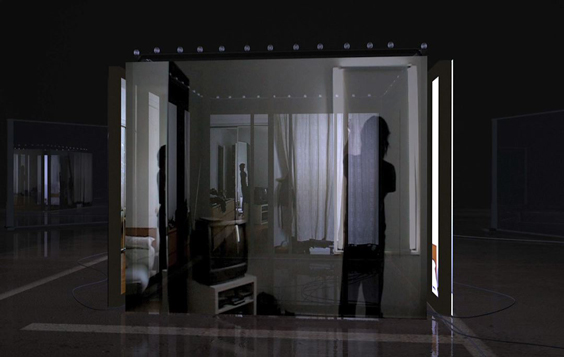
Yam Lau, Room: An Extension, 2008. Computer generated animation, digital video. © Yam Lau
MKOS: How did you start working from your home as a subject matter?
YL: Years ago I started working on my projects in my old apartment. That was very important for me because at that point I decided to withdraw myself from the art world. I just wanted to do things that were close to my way of life in my own space. Later on, around in 2007, I started working with this computer technology but I still didn’t have a subject, a big subject and then I thought I should look around my own daily activity, starting from where I was, where my home was, using this as my own subject. So you can see in this video, the routine is very mundane. It’s just a daily routine, just a guy getting up from his bed and so on.
MKOS: There are many overlapping elements of past and present time, real and unreal spaces in your work. And the computer animation enhances this virtuality of time and space, gives it a sense of illusion…
YL: I would say that I’m complicating the situation rather than overlapping it.
There is always a complexity between the real space that is shot on video, in real time, and then the computer time that seems very smooth, where space is unspecific. You don’t really know what kind of space it is or if the space has any friction. It’s an unreal time.
MKOS: Your work invites the audience to look at your intimate time and space. Was the relationship between private and public spheres also part of your concerns?
YL: Although there is a public/private dichotomy in the work, I think that element is quite minor. The action [in the video] is very mundane but it is still a performance. I performed this. The round lights you see on top of the walls are stage lights. So the whole thing is like a stage. Also the structure, you may think it’s a cube, but the inside is empty, so the outside is revealed and the space is folded inside out. I was more interested in playing with space in those formal terms.
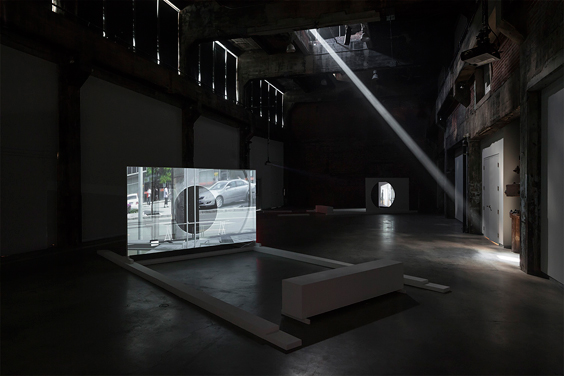
Yam Lau, A World is a Model of the World, installation view at Darling Foundry. Courtesy the artist and Darling Foundry, Montréal Photo by Guy L’Heureux
MKOS: The white structures you built for this exhibition create a link between two works, for example, the moon gate in “Room: An Extension†appears within the projection of “Between the Past and the Present…â€.
YL: Many other elements create connections, for example, you see these lines, the white lines in the video are part of the floor plan of my apartment. So the room is exactly situated there. There are formal connections but what I was really thinking when I first came to see the space at Darling Foundry was that, of course, I was attracted by this huge expansive space, and at the time it seemed so abstract. I wanted to use that idea for my work. You can see the cube in my video is surrounded by another space as well. The wooden structure that supports the video, I see it as a boat or a floating island, very much like a pavilion floating on water. I also think that this huge space, the Darling Foundry, is like rock gardens in Japan, its emptiness is punctured by my wooden structures. So the idea is that these two wooden structures float in eternal time.
MKOS: You originally studied painting and also teach in the painting department at York University in Toronto. How did your practice evolve over time?
YL: When I was painting, I could never have imagined that I would be doing this kind of work. But towards the end [of my painting practice], I was using a lot of mirrors. So I was interested in paintings that engaged with the space outside of painting. Mirrors are always more like an architectural interventions rather than paintings. For me, painting is about constructing illusions so what I’m doing here is very much a painter’s concern. I don’t think of myself as a video or digital artist. I still identify myself more with painting than with digital or video media.
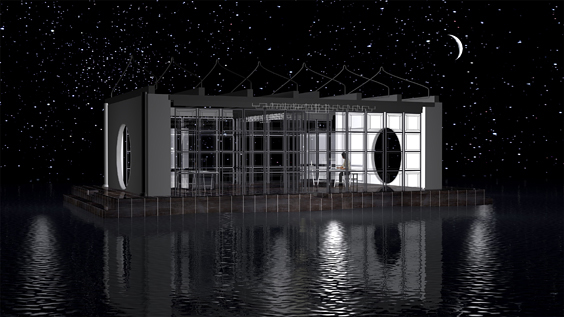
Yam Lau, Between the Past and the Present: Lived Moments in Beijing, 2012. Video still. Computer generated animation, digital video. © Yam Lau
MKOS: Similarly in these installations at Darling Foundry, you added layers of flat images as well as mirror reflections that create a virtual space or illusions of volume…
YL: Yes, they are planes essentially. For me, the idea of the image is more like a process, it has many degrees of reality. In the video you can see that it’s from real life and the planes portray real life in the cube, which then reconstruct the volumes of the room and the sensation of time, the different degrees of temporality between the video [recording] and the computer [animation]. I wanted to extend that into real space, therefore I built these structures. What’s taking place in the video actually projects out in the real space, into this wooden structure but still it’s not quite real. It’s like a maquette or a model.
MKOS: Your work recalls a 16–17 Century Zen monk quote: “Life is a temporary accommodationâ€.
YL: Many people associate me with this kind of Zen or Buddhist sensibility because the imagery seems to be very transient. They are not wrong. What I tried to do in this video [Room: An Extension] is similar to the Buddhist metaphor: The universe is a grid. It’s like a net and each juncture of the net is like a pearl. Every pearl reflects every other pearl, and every reflection in those pearls reflects all the other reflections. Each one is a model of everything else and each model contains all the other models. You can repeat that kind of mathematical recursion to infinity.
MKOS: The sense of infinity is also illustrated in your other work [Between the Past and the Present…] The composition of a night sky, the Milky Way and the moon… All this is quite romantic, is it not?
YL: I think the style is like a fairy tale but it is also inspired by French thinker Guy Debord. After 1968, he retired from Paris life and moved to the countryside. Again this idea of removing oneself, as a gesture of resistance. He was living in an old country house and he built the [surrounding] walls very high, like a castle. He wanted very tall walls that could open directly to the Milky Way, close to the stars. I like that image. Again, for me, it is about resistance, it is about setting yourself apart and closer to infinity.
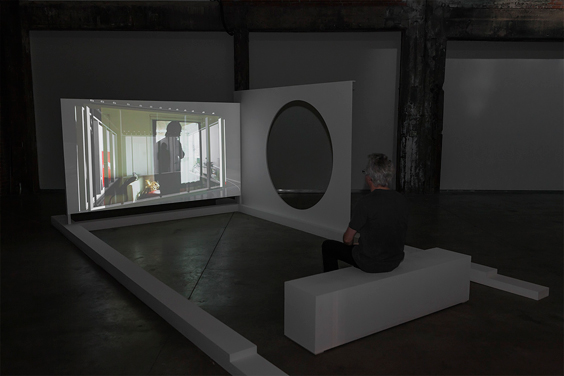
Yam Lau, Room: An Extension, 2008. Installation view from A World is a Model of the World at Darling Foundry. Courtesy the artist and Darling Foundry, Montréal. Photo by Guy L’Heureux
MKOS: And what will follow this project?
YL: I have so many different projects. I will travel soon and to explore a small region of China, where women invented their own form of writing. It’s not like standard Chinese characters. It was only taught and circulated amongst women, and looks more like Japanese Hiragana. It’s now extinct. The last person who practiced it died in early 2000 and we don’t really know much about this practice. I want to explore and make an artwork out of this writing, probably in animated form.
Also in Hong Kong and southern China, [builders] use bamboo to build scaffold instead of metal. I want to learn the technique and do something with that, perhaps build actual physical thing. I’ve also started developing the fictional idea of a Chinese tourist agency. It is an umbrella project for all my work exploring different aspects of contemporary and classical Chinese culture, including the bamboo scaffolds, street life in Beijing, my virtual courtyard house and so on… all of those could find a place in this tourist agency. â–
Interviewed by Miwa Kojima
Yam Lau was born in Hong Kong. He received his MFA from the University of Alberta and is now based in Toronto where he is an associate professor of painting at York University. Lau publishes regularly on art and design and has exhibited his work widely in Canada, USA, Europe and China. He is a co-founder of the community-based art project “Donkey Institute of Contemporary Art†in Beijing, China. His work is represented by Katzman Kamen Gallery in Canada and Yuanfen New Media Art Space in Beijing.
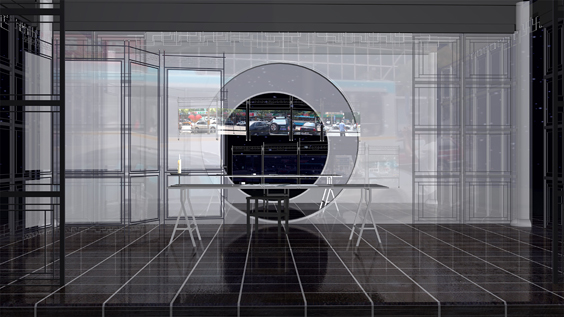
Yam Lau, Between the Pasrt and the Present: Lived Moments in Beijing, 2012. Video still. Computer generated animation, digital video. © Yam Lau
Yam Lau
A World is a Model of the World
6 June – 25 August 2013
Darling Foundry
745 Rue Ottawa,
Montréal, Québec H3C 1R8
Canada
fonderiedarling.org
Opening hours
Wednesday, Friday – Sunday: 12h00 – 19h00
Thursday: 12h00 – 22h00
*A correction was made on 19 June 2013 where it originally read “if the space has any fiction”, now changed to “if the space has any friction”
